light GMC ENVOY 1998 Owners Manual
[x] Cancel search | Manufacturer: GMC, Model Year: 1998, Model line: ENVOY, Model: GMC ENVOY 1998Pages: 386, PDF Size: 20.33 MB
Page 6 of 386
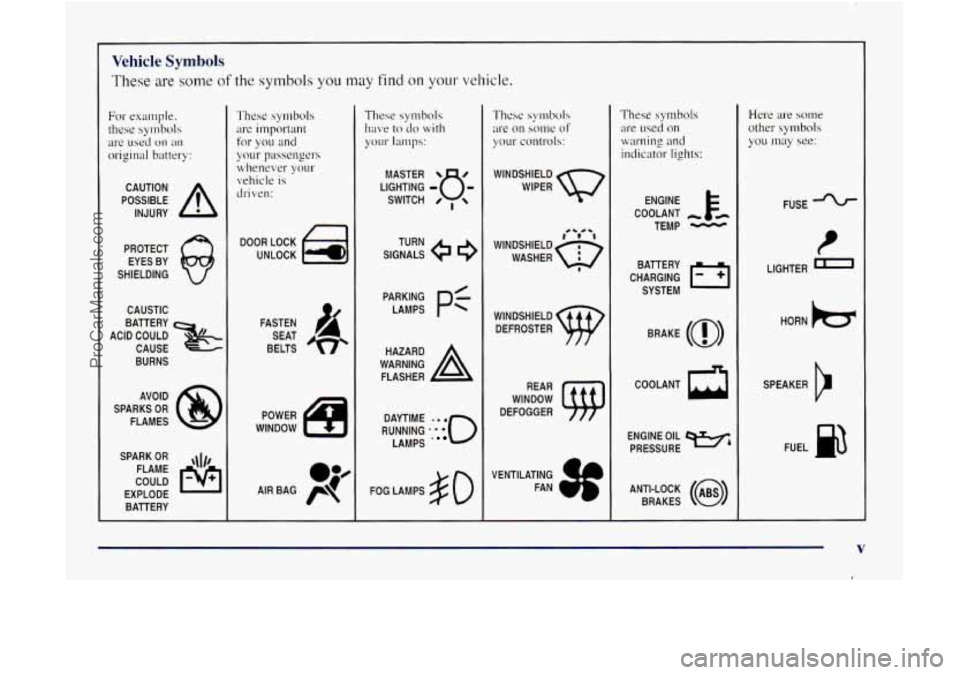
1
Vehicle Symbols
These are some of the symbols you tnay find on your vehicle.
For example.
these symbols
are used
on an
original battery:
POSSIBLE A
CAUTION
INJURY
PROTECT EYES BY
SHIELDING
CAUSTIC
ACID COULD
BATTERY
CAUSE
BURNS
AVOID
SPARKS
OR
FLAMES
SPARK
OR ,111,
COULD FLAME
EXPLODE BATTERY
These symbols
are important
for you and
your passenpel-s
whenever your vehicle
is
driven:
DOOR LOCK
UNLOCK
FA$TEll SEAT
BELTS SIGNALS
TURN
RUNNING
.':**o
DAYTIME LAMPS
*
FOG LAMPS $0
WINDSHIELD
WIPER
WINDSHIELD DEFROSTER
WINDOW
DEFOGGER
VENTILATING
i F,
FAN COOLANT
-
TEMP -
CHARGING I-1
BATTERY
SYSTEM
BRAKE
(a)
COOLANT a
ENGINE OIL w,
PRESSURE
ANTI-LOCK
(@)
BRAKES
Here are some
other symbols
you may see:
FUSE
P
LIGHTER m
HORN b
SPEAKER
b
FUEL p3
V
1
ProCarManuals.com
Page 15 of 386

Your vehicle has a light that
comes
on as a reminder to
buckle
up. (See “Safety
Belt Reminder Light”
in
the Index.)
In most states and Canadian provinces, the law says to
wear safety belts. Here’s why:
They work.
You never know if you’ll be in a crash. If you do have a
crash, you don’t know
if it will be a bad one.
A few crashes are mild, and some crashes can be so
serious that even buckled up a person wouldn’t survive.
But most crashes are in between. In many
of them,
people who buckle up can survive and sometimes walk
away. Without belts they could have been badly hurt
or killed.
After more than
30 years of safety belts in vehicles, the
facts are clear.
In most crashes buckling up does
matter
... a lot!
Why Safety Belts Work
When you ride in or on anything, you go as fast as
it goes.
I
Take the simplest vehicle. Suppose it’s just a seat
on wheels.
1-8
ProCarManuals.com
Page 20 of 386
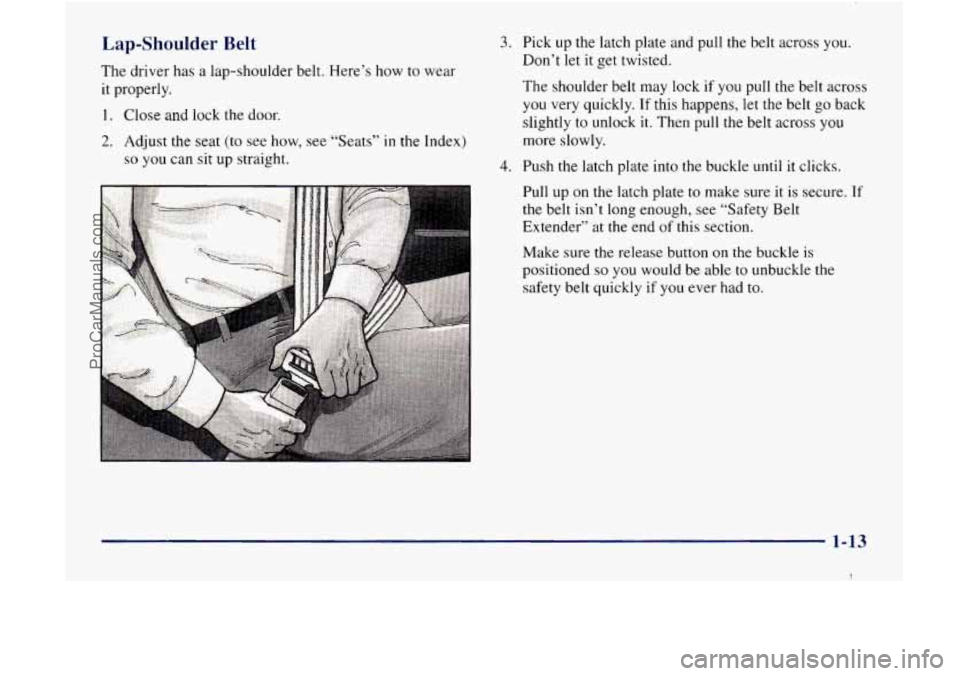
Lap-Shoulder Belt
The driver has a lap-shoulder belt. Here’s how to wear
it properly.
1. Close and lock the door.
2. Adjust the seat (to see how, see “Seats” in the Index)
so you can sit up straight.
3. Pick up the latch plate and pull the belt across you.
Don’t let it get twisted.
The shoulder belt may lock
if you pull the belt across
you very quickly. If this happens, let the belt
go back
slightly to unlock it. Then pull the belt across
you
more slowly.
4. Push the latch plate into the buckle until it clicks.
Pull up on
the latch plate to make sure it is secure. If
the belt isn’t long enough, see “Safety Belt
Extender’’ at the end
of this section.
Make sure the release button on the buckle is
positioned
so you would be able to unbuckle the
safety belt quickly if
you ever had to.
1-13
ProCarManuals.com
Page 29 of 386
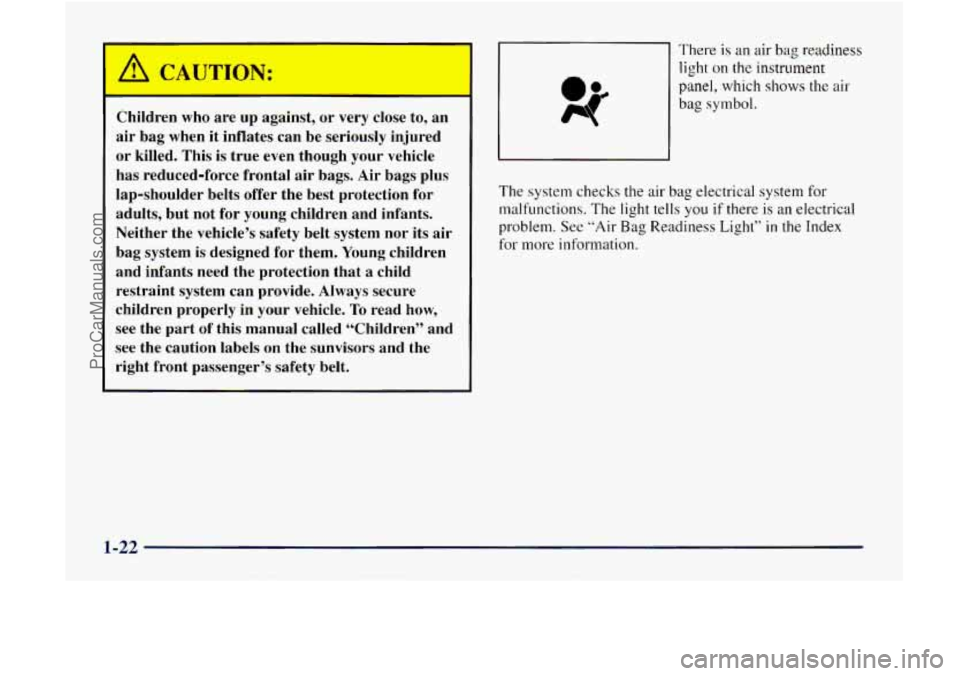
r-
Children who ar ~p against, or very close to, an
air bag when it inflates can be seriously injured
or killed. This is true even though your vehicle
has reduced-force frontal air bags.
Air bags plus
lap-shoulder belts offer the best protection for
adults, but not for young children and infants.
Neither the vehicle’s safety belt system nor its air
bag system is designed for them. Young children
and infants need the protection that a child
restraint system can provide. Always secure
children properly in your vehicle.
To read how,
see the part of this manual called “Children” and
see the caution labels on the sunvisors and the
right front passenger’s safety belt.
There is an air bag readiness
light
on the instrument
panel, which shows the air
bag symbol.
The system checks the air bag electrical system for
malfunctions. The light tells
you if there is an electrical
problem. See “Air
Bag Readiness Light” in the Index
for
more information.
ProCarManuals.com
Page 35 of 386
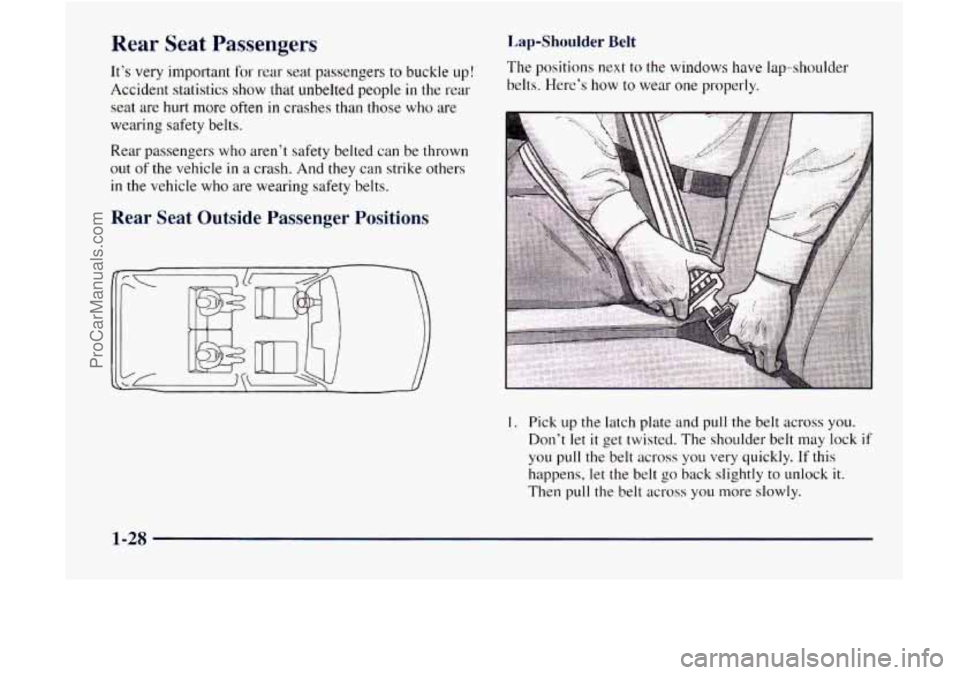
Rear Seat Passengers
It's very important for rear seat passengers to buckle up!
Accident statistics show that unbelted people in the rear
seat are hurt more often
in crashes than those who are
wearing safety belts.
Rear passengers who aren't safety belted can be thrown
out
of the vehicle in a crash. And they can strike others
in the vehicle who are wearing safety belts.
Lap-Shoulder Belt
The positions next to the windows have lap-shoulder
belts. Here's how
to wear one properly.
Rear Seat Outside Passenger Positions
I. Pick up the latch plate and pull the belt across you.
Don't let
it get twisted. The shoulder belt may lock if
you pull the belt across you very quickly. If this
happens, let the belt
go back slightly to unlock it.
Then pull the belt across you more slowly.
1-28
ProCarManuals.com
Page 59 of 386
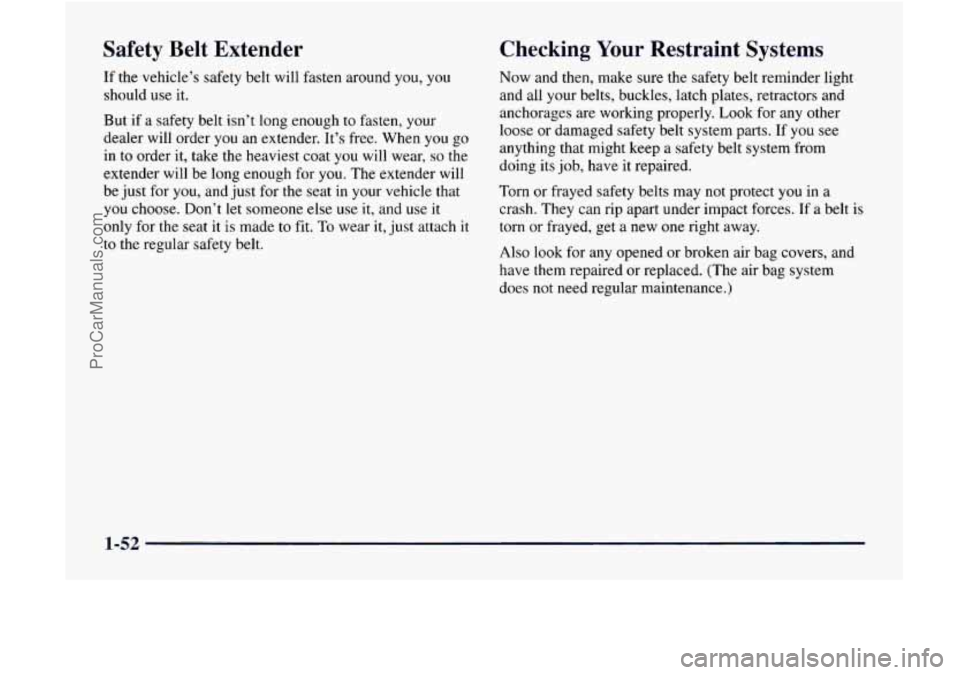
Safety Belt Extender
If the vehicle’s safety belt will fasten around you, you
should use it.
But if a safety belt isn’t long enough to fasten, your
dealer will order you an extender. It’s free. When
you go
in to order it, take the heaviest coat you will wear, so the
extender will be long enough for you. The extender will
be just for
you, and just for the seat in your vehicle that
you choose. Don’t let someone else use it, and use it
only for the seat it
is made to fit. To wear it, just attach it
to the regular safety belt.
Checking Your Restraint Systems
Now and then, make sure the safety belt reminder light
and all your belts, buckles, latch plates, retractors and
anchorages are working properly.
Look for any other
loose or damaged safety belt system parts. If you see
anything that might keep a safety belt system from
doing its job, have it repaired.
Torn or frayed safety belts may not protect
you in a
crash. They can rip apart under impact forces.
If a belt is
torn or frayed, get a new one right away.
Also look for any opened or broken air bag covers, and
have them repaired or replaced. (The air bag system
does not need regular maintenance.)
1-52
ProCarManuals.com
Page 62 of 386

Section 2 Features and Controls
Here you can learn about the many standard and optional features on your vehicle, \
and information on starting,
shifting and braking. Also explained
are the instrument panel and the warning systems that tell you if everything is
working properly
-- and what to do if you have a problem.
2-2 2-4
2-6
2-9 2-10 2-1 1
2-12
2- 13
2- 14
2- 15
2- 16
2-18 2-20
2-2
1
2-23 2-24
2-24
2-25 Keys
Door Locks
Keyless Entry System
LiftgateLiftglass
Theft Content Theft-Deterrent
Passlock@ New Vehicle “Break-In’’
Ignition Positions Starting Your Engine
Engine Coolant Heater
(If Equipped)
Automatic Transmission Operation
Parking Brake Shifting Into PARK (P)
Shifting Out of PARK
(P)
Parking Over Things That Burn
Engine Exhaust Running Your Engine While You’re Parked 2-26
2-26
2-28 2-29
2-30
2-30 2-36
2-39
2-40
2-42
2-49 2-50
2-52 2-52
2-53 2-58 2-60
2-62 Locking Rear Axle
Four-wheel Drive
Windows Horn
Tilt Wheel Turn SignalMultifunction Lever
Exterior Lamps
Interior Lamps
Mirrors Storage Compartments
Ashtrays and Cigarette Lighter
Sun Visors
Accessory Power Outlets Sunroof (If Equipped)
Universal Transmitter Instrument Panel
Instrument Panel Cluster
Warning Lights, Gages and Indicators
2-1
ProCarManuals.com
Page 68 of 386

Operation
UNLOCK: Pressing this button once will unlock the
driver’s door. The parking lamps will flash and the
interior lights will come
on. Pressing this button once
also unlocks the rear liftglass. Pressing
UNLOCK again
within three seconds will cause the remaining doors to
unlock. The parking lamps will flash and
the interior
lights will come on.
LOCK: Pressing this button once will lock all of the
doors. Press LOCK again within three seconds and the
horn will chirp.
REAR: Press this button twice within three seconds to
release the liftglass. The parking lamps will flash and
the interior lights will come on. The transmission must
be PARK
(P) or NEUTRAL (N).
Remote Panic Alarm
When the button with the horn symbol on the key
transmitter is pressed, the horn will sound and
the
headlamps and taillamps will flash for up to 30 seconds.
This can be turned off by pressing the horn button again,
waiting for
30 seconds, or starting the vehicle.
Matching Transmitter(s) To Your Vehicle
Each remote keyless entry transmitter is coded to
prevent another transmitter from unlocking your vehicle.
If
a transmitter is lost or stolen, a replacement can be
purchased through your dealer. Remember
to bring any
remaining transmitters with you
when you go to your
dealer. When the dealer matches the replacement
transmitter
to your vehicle, any remaining transmitters
must also be matched. Once your dealer has coded
the
new transmitter, the lost transmitter will not unlock your
vehicle. Each vehicle can have only four transmitters
matched to it.
2-7
1
ProCarManuals.com
Page 72 of 386

Key in the Ignition
If you leave your vehicle with the keys inside, it’s an
easy target for joy riders or professional thieves
-- so
don’t do it.
When you park your vehicle and open the driver’s door,
you’ll hear a chime reminding
you to remove your key
from the ignition and take
it with you. Always do this.
Your steering wheel will be locked, and
so will your
ignition and transmission. And remember to lock
the doors.
Parking at Night
Park in a lighted spot, close all windows and lock your
vehicle. Remember to keep your valuables out
of sight.
Put them
in a storage area, or take them with you.
Parking Lots
If you park in a lot where someone will be watching
your vehicle, it’s best to lock it up and take your keys.
But what
if you have to leave your ignition key? What if
you have to leave something valuable in your vehicle?
Put your valuables in a storage area, like your
glove box.
Lock all the doors except the driver’s.
Content Theft-Deterrent
Your vehicle is equipped
with
a Content
Theft-Deterrent
SECURITY alarm system.
With this system, the SECURITY light will flash as
you
open the door (if your ignition is off).
This light reminds you to activate the theft-deterrent
system. Here’s how
to do it:
1. Open the door.
2. Lock the door with the power door lock switch or the
remote keyless entry transmitter. The SECURITY
light should come
on and stay on.
3. Close all doors. The SECURITY light should go off
after approximately
30 seconds. The alarm is not
armed until the SECURITY light goes off.
If a door is opened without the key or the remote keyless
entry transmitter, the alarm will go
off. Your vehicle’s
high-beam headlamps will flash
and the horn will sound
for
30 seconds, then will turn off to save the battery power.
2-11
I
ProCarManuals.com
Page 73 of 386

Remember, the theft-deterrent system won‘t activate if
you lock the doors with a key or use the manual door
lock. It activates only if
you use a power door lock
switch with the door open, or with the remote keyless
entry transmitter. You should
also remember that you
can start your vehicle with the correct ignition key
if’ the
alarm has been set
off.
Here’s how to avoid setting off the alarm by accident:
If you don’t want to activate the theft-deterrent
system, the vehicle should be locked
with the door
key
after the doors are closed.
Always unlock a door with a key, or use the remote
keyless entry transmitter. Unlocking
a door any other
way will set off the alarm.
If you set off the alarm by accident, unlock any door
with the key. You can
also turn off the alarm by pressing
UNLOCK on the remote keyless entry transmitter.
The alarm won’t stop if you try to unlock a door any
other way.
Testing the Alarm
The alarm can be tested by following these steps:
I. From inside the vehicle, lower the driver‘s window
and open the driver’s door.
3.
4.
Activate the system by locking the doors with the
power door
lock switch while the door is open, or
with the remote keyless entry transmitter.
Get out
of the vehicle, close the door and wait for the
SECURITY light to
go out.
Then reach
in through the window, unlock the door
with the manual door lock and open the door. This
should set
off the alarm.
If the alarm does not sound when it should but the
vehicle’s high-beam headlamps flash, check
to see if the
horn works. The horn fuse may be blown.
To replace the
f~~se, see “Fuses and Circuit Breakers”
in the Index.
If the alarm does not sound or the vehicle’s high-beam
headlamps do not flash, the vehicle should be serviced
by
an authorized service center.
Passlock’
Your vehicle is equipped with the Passlock
theft-deterrent system.
Passlock is
a passive theft-deterrent system. The system
is armed once the key is removed from the ignition.
Passlock enables fuel
if the ignition lock cylinder is
turned with a valid key. If a correct key is not used, fuel
is disabled.
2-12
ProCarManuals.com